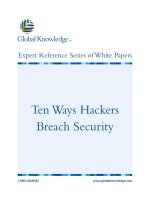WEB Security pdf
Bạn đang xem bản rút gọn của tài liệu. Xem và tải ngay bản đầy đủ của tài liệu tại đây (366.62 KB, 22 trang )
Henric Johnson 1
Chapter 7
WEB Security
Henric Johnson
Blekinge Institute of Technology, Sweden
/>
Henric Johnson 2
Outline
• Web Security Considerations
• Secure Socket Layer (SSL) and Transport
Layer Security (TLS)
• Secure Electronic Transaction (SET)
• Recommended Reading and WEB Sites
Henric Johnson 3
Web Security Considerations
• The WEB is very visible.
• Complex software hide many security flaws.
• Web servers are easy to configure and
manage.
• Users are not aware of the risks.
Henric Johnson 4
Security facilities in the
TCP/IP protocol stack
Henric Johnson 5
SSL and TLS
• SSL was originated by Netscape
• TLS working group was formed within IETF
• First version of TLS can be viewed as an
SSLv3.1
Henric Johnson 6
SSL Architecture
Henric Johnson 7
SSL Record Protocol Operation
Henric Johnson 8
SSL Record Format
Henric Johnson 9
SSL Record Protocol
Payload
Henric Johnson 10
Handshake Protocol
• The most complex part of SSL.
• Allows the server and client to
authenticate each other.
• Negotiate encryption, MAC algorithm and
cryptographic keys.
• Used before any application data are
transmitted.
Henric Johnson 11
Handshake Protocol Action
Henric Johnson 12
Transport Layer Security
•
The same record format as the SSL record format.
• Defined in RFC 2246.
• Similar to SSLv3.
• Differences in the:
– version number
– message authentication code
– pseudorandom function
– alert codes
– cipher suites
– client certificate types
– certificate_verify and finished message
– cryptographic computations
– padding
Henric Johnson 13
Secure Electronic Transactions
•
An open encryption and security
specification.
•
Protect credit card transaction on the
Internet.
• Companies involved:
– MasterCard, Visa, IBM, Microsoft,
Netscape, RSA, Terisa and Verisign
•
Not a payment system.
•
Set of security protocols and formats.
Henric Johnson 14
SET Services
• Provides a secure communication channel in
a transaction.
• Provides tust by the use of X.509v3 digital
certificates.
• Ensures privacy.
Henric Johnson 15
SET Overview
• Key Features of SET:
– Confidentiality of information
– Integrity of data
– Cardholder account authentication
– Merchant authentication
Henric Johnson 16
SET Participants
Henric Johnson 17
Sequence of events for
transactions
1. The customer opens an account.
2. The customer receives a certificate.
3. Merchants have their own certificates.
4. The customer places an order.
5. The merchant is verified.
6. The order and payment are sent.
7. The merchant request payment authorization.
8. The merchant confirm the order.
9. The merchant provides the goods or service.
10. The merchant requests payments.
Henric Johnson 18
Dual Signature
H(OI))]||)(([ PIHHEDS
c
KR
=
Henric Johnson 19
Payment processing
Cardholder sends Purchase Request
Henric Johnson 20
Payment processing
Merchant Verifies Customer Purchase Request
Henric Johnson 21
Payment processing
• Payment Authorization:
– Authorization Request
– Authorization Response
• Payment Capture:
– Capture Request
– Capture Response
Henric Johnson 22
Recommended Reading and
WEB sites
• Drew, G.
Using SET for Secure Electronic
Commerce
. Prentice Hall, 1999
•
Garfinkel, S., and Spafford, G. Web
Security & Commerce. O’Reilly and
Associates, 1997
•
MasterCard SET site
•
Visa Electronic Commerce Site
• SETCo (documents and glossary of terms)









